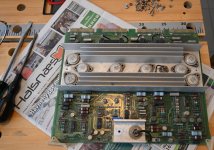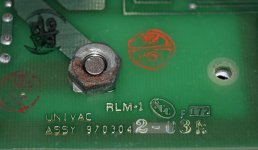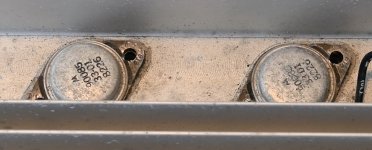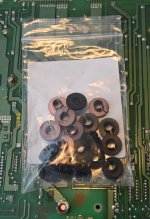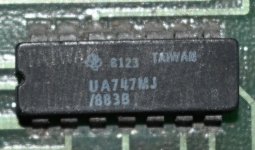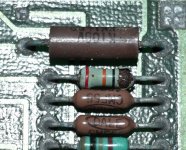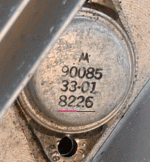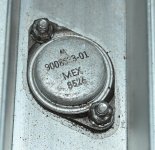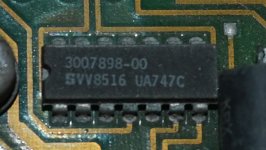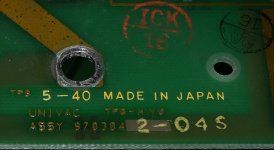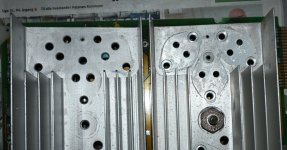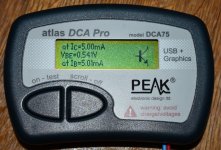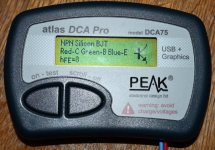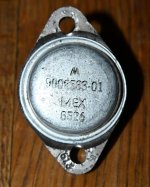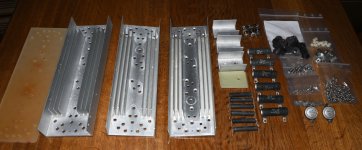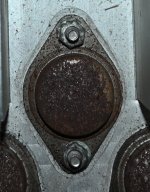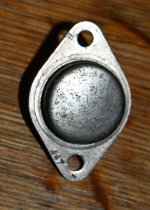I got 3x old computer boards home where I want to use the on-board heatsinks for testing TO-3's. One of the boards is shown where I have started the "process".
Then I got interested in the history:
The computer board is labeled "UNIVAC" which was a very old US computer brand. The PCB has a date "970304"? .....1997 does not fit with anything "UNIVAC"?
The TO-3's on heatsink are some old Motorola stuff. Those has no place in audio?
I intend to trash them.....
I have saved small heatsinks that was mounted on the small signal transistors.
Board is from a time where Dale resistors was Dale and not Vishay.
Then I got interested in the history:
The computer board is labeled "UNIVAC" which was a very old US computer brand. The PCB has a date "970304"? .....1997 does not fit with anything "UNIVAC"?
The TO-3's on heatsink are some old Motorola stuff. Those has no place in audio?
I intend to trash them.....
I have saved small heatsinks that was mounted on the small signal transistors.
Board is from a time where Dale resistors was Dale and not Vishay.
Attachments
"970304" is too long and too specific to mean a date code, it´s most certainly a board number, they won´t *etch* a code valid for only *one* day.
Computer printed paper stickers are fair game, of course.
Date codes are 4 digits (year-week) or 3 digit, year-week where only second year digit is used, decade is usually esier to assume from other clues.
Here are a couple Peavey amplifier boards, identified as:
120486 - 090987 - 031307 .
All include an extra label: [c]Peavey 1987

Computer printed paper stickers are fair game, of course.
Date codes are 4 digits (year-week) or 3 digit, year-week where only second year digit is used, decade is usually esier to assume from other clues.
Here are a couple Peavey amplifier boards, identified as:
120486 - 090987 - 031307 .
All include an extra label: [c]Peavey 1987
Ok, I would also assume that those boards are much older. It also has TTL-like logic on them. So from the 70 or 80 would make more sense.
They are probably original UNIVAC boards from a computer they made back then.
They are probably original UNIVAC boards from a computer they made back then.
Don't know if any of the codes of the IC is a date code?
Funny that the brown CMF55 resistors many uses today was "Dale" branded back then. Are they made at the same factory today?
I have released one of the heatsinks today. Two remaining.
Funny that the brown CMF55 resistors many uses today was "Dale" branded back then. Are they made at the same factory today?
I have released one of the heatsinks today. Two remaining.
Attachments
8838 does look like a date code, specially on an IC; not much so if etched on a board.
EDIT:
and
So much so, they wre featured in Isaac Asimov´s SF novels of that era, go figure; sometimes disguised as "Multivac" so as not to write the actual name.
EDIT:
and
is much earlier than you think, from early 50´s or so."UNIVAC" which was a very old US computer brand
So much so, they wre featured in Isaac Asimov´s SF novels of that era, go figure; sometimes disguised as "Multivac" so as not to write the actual name.
Last edited:
The "9703042-03N" is clearly the part number of the PCB assembly (abbreviated "ASSY"). The "03N" is probably a revision level indicating how many "Engineering Change Orders" have been incorporated into the assembly. These ECN's may include component changes or "Blue Wires". "9703042" may be the part number of the naked PCB without components, or that may be marked in a different area of the PCB, possibly hidden under the heat sink. Those Motorola power transistors clearly have date codes from 1982.
Univac computers were made with Vacuum tubes, the only thing solid state may have been Selenium rectifiers.
Univac computers were made with Vacuum tubes, the only thing solid state may have been Selenium rectifiers.
Last edited:
Univac
The TI DIP package is a dual op-amp uA747. The end of the part number is /883B. This is a MIL SPEC screening identifier. The date code is the 8123. 23rd week of 1981.
The original UNIVAC computers were built by the Eckert-Mauchly Computer Corporation. They were tube based. The UNIVAC trade name was continued by the successor companies Remington Rand, Sperry, Sperry Rand and Unisys. These later computers were built with transistors and then Integrated Circuits. The last UNIVAC badged computer was produced in 1986.
(28 year Sperry /Unisys engineer)
The TI DIP package is a dual op-amp uA747. The end of the part number is /883B. This is a MIL SPEC screening identifier. The date code is the 8123. 23rd week of 1981.
The original UNIVAC computers were built by the Eckert-Mauchly Computer Corporation. They were tube based. The UNIVAC trade name was continued by the successor companies Remington Rand, Sperry, Sperry Rand and Unisys. These later computers were built with transistors and then Integrated Circuits. The last UNIVAC badged computer was produced in 1986.
(28 year Sperry /Unisys engineer)
I was surprised by the dual opamp in that type of package. From distance it looked like a TTL-logic IC. The opamp seems to be still available today. It is mentioned that it is fine as a follower. It is in a ceramic package which also indicate "MIL SPEC". Probably UNIVAC computers was used by the "defense" so MIL SPEC was required.
Seems to be a history that a UNIVAC computer predicted the outcome of a Presidents election.
Ok......so we have a member that has been.....almost......in the company. So Unisys took over the development.
Seems to be a history that a UNIVAC computer predicted the outcome of a Presidents election.
Ok......so we have a member that has been.....almost......in the company. So Unisys took over the development.
UNIVAC was even before the Swedish "BESK" and the Danish "DASK".
DASK - Wikipedia
ENIAC the first of them all.....
DASK - Wikipedia
ENIAC the first of them all.....
The T03 things are dated 82-26 or mid 1982. They are house-numbered: only Moto and UNIVAC would know the exact specs. (It may be a common part but sorted-out to a higher OR lower spec.)
The '747 dated mid-1981 does not conflict: jellybean parts may be in a bin for months, while costly T03's might get ordered just-in-time.
The UNIVAC name was too well known to die, and Bill confirms it was in-use in the 1981-1982 era. But there's a lot of dead-ends on the computer tree and UNIVAC vanished.
My father was looking for a job at the end of the UNIVAC I era and got work at another company which, like Sperry et al, became "the seven dwarfs". Change change change: he left that shop just before it got sold to another dwarf in the UNIVAC family.
The '747 dated mid-1981 does not conflict: jellybean parts may be in a bin for months, while costly T03's might get ordered just-in-time.
The UNIVAC name was too well known to die, and Bill confirms it was in-use in the 1981-1982 era. But there's a lot of dead-ends on the computer tree and UNIVAC vanished.
My father was looking for a job at the end of the UNIVAC I era and got work at another company which, like Sperry et al, became "the seven dwarfs". Change change change: he left that shop just before it got sold to another dwarf in the UNIVAC family.
Attachments
Last edited:
Found curious the "33-01" label , which makes me think it could be an equivalent to the famous "IBM 133" transistor, which obviously was used in the same market: computers.
Maybe a way to hint at similarity without infringing trademarks???????
Specially IBM trademarks, way back then the King of the Jungle.
IBM- 133_RT, Tube IBM-133_RT; Rohre IBM- 133_RT ID39103, Tra
Just short ago somebody was asking about a stash of IBM 133 transistors he had found, most made by Motorola, but a couple by ST and Siemens, go figure.
One of the pictures posted:
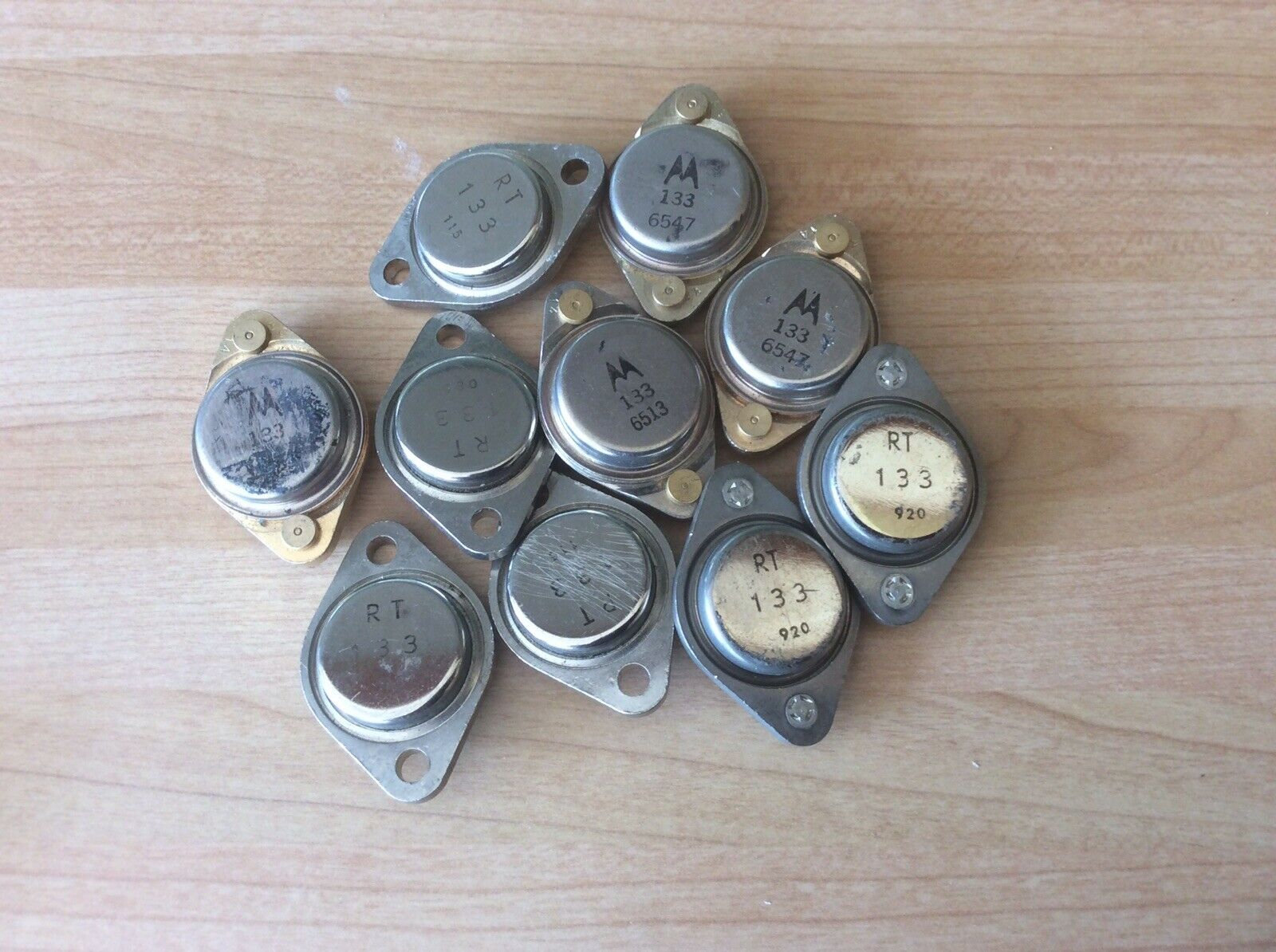
At some point in History they must have been a hot item to manufacture.
Maybe a way to hint at similarity without infringing trademarks???????
Specially IBM trademarks, way back then the King of the Jungle.
IBM- 133_RT, Tube IBM-133_RT; Rohre IBM- 133_RT ID39103, Tra
Just short ago somebody was asking about a stash of IBM 133 transistors he had found, most made by Motorola, but a couple by ST and Siemens, go figure.
One of the pictures posted:
At some point in History they must have been a hot item to manufacture.
Last edited:
My guess is that the TO-3's are normal silicon transistors and not germanium but has not measured then. They are also gone now apart from the last of the 3 boards which is a newer revision from about 1985 and PCB now say "Made in Japan". Also the dual op-amp IC's are plastic and not ceramic.
So far I have two clean heatsinks for TO-3 and some additional power resistors which I saved and a few other "garnitures".
So far I have two clean heatsinks for TO-3 and some additional power resistors which I saved and a few other "garnitures".
Attachments
Ah!!! when mighty Japan was conquering the World with Quality and Technology!!!a newer revision from about 1985 and PCB now say "Made in Japan".
Until in the 90´s they also had the foolish idea that Real Estate and Stock Market speculation was a cool way to make money 🙄 😕
Yes, and as we know they have attention to the details and "refinement" of products.
As can be seen on Japan-revision of the TO-3 heatsinks (to the right). Now TO-3 mounting screws has "isolators" (one isolator is still present in the hole). None isolators present on the older revision. I will keep those isolators.
Most of the TO-3's has steel-cover (not aluminium) as they are rusty. Will try to clean and see what is written on it. And why not see if a transistor tester can measure anything not we have talked about the devices. I am quite sure they are not VFETs.
As can be seen on Japan-revision of the TO-3 heatsinks (to the right). Now TO-3 mounting screws has "isolators" (one isolator is still present in the hole). None isolators present on the older revision. I will keep those isolators.
Most of the TO-3's has steel-cover (not aluminium) as they are rusty. Will try to clean and see what is written on it. And why not see if a transistor tester can measure anything not we have talked about the devices. I am quite sure they are not VFETs.
Attachments
Here are want I got out of the $20 investment (incl. shipping):
3x TO-3 heatsinks and 3x smaller heatsinks (alu bracket like).
6x "small" DALE power resistors (0.5 ohm 10W). In serial they could be a compact 3 ohm / 60W low impedance test load for amp testing.
6x "large" DALE power resistors (0.2 ohm 25W). 5 of those in serial connection gives a very low impedance 1 ohm 125W load resistor. Which amp can deliver 125W in 1 ohm?
Some additional M3 screws etc. I have a lot of M3 screws already but maybe not that length so why not keep them. Also they looks good compared to "modern" types.
I may couple 2 x TO-3 heatsinks back to back. If I solder a wire to the TO-3 pins before mounting it should work. We will see what I do.
Then there is attached a measurement of one of the TO-3 devices. It just shows it is a NPN and it probably works.
3x TO-3 heatsinks and 3x smaller heatsinks (alu bracket like).
6x "small" DALE power resistors (0.5 ohm 10W). In serial they could be a compact 3 ohm / 60W low impedance test load for amp testing.
6x "large" DALE power resistors (0.2 ohm 25W). 5 of those in serial connection gives a very low impedance 1 ohm 125W load resistor. Which amp can deliver 125W in 1 ohm?
Some additional M3 screws etc. I have a lot of M3 screws already but maybe not that length so why not keep them. Also they looks good compared to "modern" types.
I may couple 2 x TO-3 heatsinks back to back. If I solder a wire to the TO-3 pins before mounting it should work. We will see what I do.
Then there is attached a measurement of one of the TO-3 devices. It just shows it is a NPN and it probably works.
Attachments
Cool!
Great trashcan find!
Just joking 😉 , for only $20 it almost counts as such.
The heatsinks and resistors are immediately usable; as of the power transistors you need to measure Vce they can stand unless going up in a puff of smoke is an acceptable test system for you 😉
You´ll need to stress them more than PEAK does, that´s for sure.
One quick and dirty method I use when checking "mystery transistor" finds or even suspect counterfeit ones is to get some high volage supply , say 200-300-400V (do you have any Tube amp nearby to "borrow" some voltage?
Something way above what you might expect (which would be something between, say, 50 to 100V Vce) , ALL would have cheated a meter such as PEAK, go figure, then exploding inside a real Guitar amp.
Short BE together and connect them to suppy negative, then connect Collector to >200V supply through, say, a 22k 2W resistor.
Test lasts all of 10-15 seconds so even if that resistor starts heating up (it will) you will normally not burn,not even toast it.
Worst case use higher power one, or two 10k 2W in series.
Measure transistor breakdown voltage.
Some call it "Zener voltage" but it´s not, it does not behave like a Zener, has negative resistance coefficient, etc. , but is a useful parameter anyway.
And such low current will NOT damage a TO3 class transistor
Once you found some value, say 80Vce breakdown, use that transistor applying some safety derating factor, say 20%-25% so in this case no more than 50 or 60 V tops.
Between 2004 and 2008 when the FAKE tsunami started, I had to test all of my workhorse 2N3055 from different suppliers and found many with abysmal 40-50 Vce , one with only 30 Vce 😱
I was so fed up that I had to abandon them after 35 years of faithful service and switch to TIP142/147 , what most of the MI industry did by the way. (Fender, Crate, Marshall, Laney, H&K, etc.)
So measure those , you might make a couple mid power amps with them.
Say 30 to 60W per channel, not bad.
I designed a "universal" PCB which can take NPN-PNP-TO3-TO218-TO247-Darlingtons so junkbin-mystery-"pulls" transistors are not wasted.
Great trashcan find!
Just joking 😉 , for only $20 it almost counts as such.
The heatsinks and resistors are immediately usable; as of the power transistors you need to measure Vce they can stand unless going up in a puff of smoke is an acceptable test system for you 😉
You´ll need to stress them more than PEAK does, that´s for sure.
One quick and dirty method I use when checking "mystery transistor" finds or even suspect counterfeit ones is to get some high volage supply , say 200-300-400V (do you have any Tube amp nearby to "borrow" some voltage?
Something way above what you might expect (which would be something between, say, 50 to 100V Vce) , ALL would have cheated a meter such as PEAK, go figure, then exploding inside a real Guitar amp.
Short BE together and connect them to suppy negative, then connect Collector to >200V supply through, say, a 22k 2W resistor.
Test lasts all of 10-15 seconds so even if that resistor starts heating up (it will) you will normally not burn,not even toast it.
Worst case use higher power one, or two 10k 2W in series.
Measure transistor breakdown voltage.
Some call it "Zener voltage" but it´s not, it does not behave like a Zener, has negative resistance coefficient, etc. , but is a useful parameter anyway.
And such low current will NOT damage a TO3 class transistor
Once you found some value, say 80Vce breakdown, use that transistor applying some safety derating factor, say 20%-25% so in this case no more than 50 or 60 V tops.
Between 2004 and 2008 when the FAKE tsunami started, I had to test all of my workhorse 2N3055 from different suppliers and found many with abysmal 40-50 Vce , one with only 30 Vce 😱
I was so fed up that I had to abandon them after 35 years of faithful service and switch to TIP142/147 , what most of the MI industry did by the way. (Fender, Crate, Marshall, Laney, H&K, etc.)
So measure those , you might make a couple mid power amps with them.
Say 30 to 60W per channel, not bad.
I designed a "universal" PCB which can take NPN-PNP-TO3-TO218-TO247-Darlingtons so junkbin-mystery-"pulls" transistors are not wasted.
Last edited:
Thank you very much for describing a test-method.
I only kept two of the TO-3's with alu-top.
On the "made in Japan" PCB there were 6 x TO-3's with steel-top. I like those better but they were covered by a layer of rust as you can see. But some chemical treatment (phosphoric acid based) cured it ("somehow") and it measures well (Hfe = 88). The others will "overnight" in chemicals. I threat them as old vintage rusty carbon steel knives.
I have a 300B PSU at approx. 540 VDC.
The on-board TO-3's was for fun. Heatsinks was mostly for testing other TO-3's like the VFETs etc......but these old rusty parts could be good for practice.......
I only kept two of the TO-3's with alu-top.
On the "made in Japan" PCB there were 6 x TO-3's with steel-top. I like those better but they were covered by a layer of rust as you can see. But some chemical treatment (phosphoric acid based) cured it ("somehow") and it measures well (Hfe = 88). The others will "overnight" in chemicals. I threat them as old vintage rusty carbon steel knives.
I have a 300B PSU at approx. 540 VDC.
The on-board TO-3's was for fun. Heatsinks was mostly for testing other TO-3's like the VFETs etc......but these old rusty parts could be good for practice.......
Attachments
Now after rust removal the 6 x TO-3's are good to go for the next 40 years (a powder coat would look good). They all measures well. 3 to the left are PNP's and 3 to the right are NPN's so maybe a small PP amp for the future. But think a bipolar output stage is unrealistic and they were not part of the plan.
Attachments
- Home
- Amplifiers
- Pass Labs
- Heatsinks for testing TO-3 (VFET and other)
